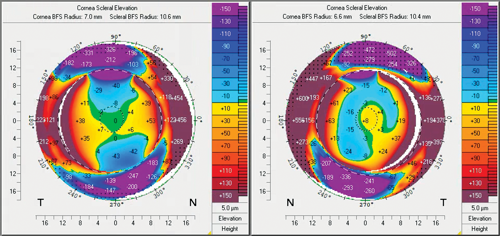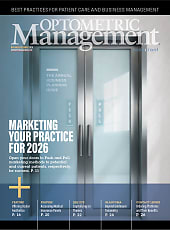Scleral lenses are a great option for vision correction but present their own challenges over alternative lens types. What should be typical scleral fits aren’t always so simple. Using highly customizable, versatile lens designs can give the eye care provider the ability to manage challenges without switching designs during the fitting process.
Case Description
A 64-year-old male patient presented to our office with a history of mild keratoconus OD and OS. He is a longtime gas-permeable (GP) lens wearer but is interested in other vision correction options. As a K9 police officer, he was seeking lens correction that provided more stability and could be worn for the duration of his long 14-plus-hour workdays. The patient decided to proceed with scleral lenses over other alternative options such as soft keratoconus lenses or hybrids.
The scleral fitting initially appeared to be a very straightforward case: The patient presented with mild keratoconus OD<OS, refraction -3.75 -0.50 x 060, -7.50 sph. Best-corrected visual acuity (BCVA) was 20/25- OD, 20/50- OS. Scleral profilometry revealed a large amount of scleral toricity of 718 µm and 990 µm with-the-rule, OD, OS respectively, at a 16.5-mm chord. This was unexpected, as scleral toricity is typically reflective of the cornea in orientation and severity. Tomography scans showed only mild with-the-rule anterior corneal toricity OD and mild against-the-rule toricity OS (see Figure 1).
In-office diagnostics aren’t typically able to accommodate such scleral toricity, but we utilized the closest diagnostic lens available to start the fitting process. Custom lenses were then designed, ordered, and fit. Due to the amount of toricity, we had difficulty getting a standard scleral lens to land correctly on the vertical meridian, especially the left eye. Several revisions were made, but ultimately, we were unable create a lens that could accommodate the high amount of scleral toricity. This led to a poor lens seal and lens discomfort, as well as fogging after only 1 hour. Because the current lens had reached its customization limit, we felt an alternative lens design would be necessary to properly fit this patient.
We changed our approach and then decided to utilize a profilometry-guided freeform lens. The Maxim3D (Acculens) freeform scleral lenses were designed based off profilometry data. The freeform lens design process allowed for optimization to account for the full level of toricity present.
The first lens designed was near perfect fit and 20/20 vision OD, OS. A second set was ordered to account for some last minor adjustments. The patient was able to wear the lenses for the full 14-plus-hour workday without discomfort or fogging issues.
Discussion
This case may hit close to home for those practitioners who have had a scleral lens case that appeared easy but found getting to the finish line more difficult than initially thought. Switching designs during the fitting process is never ideal. Using the freeform design initially would have reduced chair time and the number of visits and improved the patient’s overall experience.
Conclusion
In the end, we were able to deliver a near-perfect lens that could be worn 14-plus hours, with 20/20 OD, OS. The patient was happy and felt the new scleral lenses were an improvement over his previous GP lenses in many ways. Although we encountered a few hiccups, we were able to right the ship and get this patient taken care of.

To hear Dr. Sturm discuss this case, click here.




